
In my research I have not found many small hairdressing businesses that use email marketing as a technique, and more specifically newsletters – even the most prestigious of businesses with a Central London location… This got me thinking, why?
It could be because businesses feel that they don’t need to, as their competitors don’t either, a lack of financial resources, time constraints and expertise that could mean businesses don’t want to invest into digital resources, and the associated time this would take to implement. The most important factor could be simply because they don’t need to, especially ones with a Central London location, this in itself provides exposure and daily footfall to their premises.
However, if you’re interested in starting email marketing and newsletters, download HubSpots (2014) free and downloadable ‘How to create email newsletters that don’t suck’ which is the ultimate BIBLE for newsletter creation. Topics are indicated below…
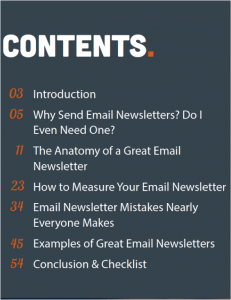
OR… create your newsletter here now via Constant Contact (2015)!
Here’s why newsletters are great – according to HubSpot (2014):
- Spread brand awareness (by building habitual communication with your email subscribers, you enable them to recognise your brand/business and associate it with a positive sentiment)
- Leverage existing content (e.g a quick summary of your most popular blog posts and link it to any new news/social media sites)
- Include different types of content (e.g. the same newsletter can contain a blog post, a new offer, social media sites, an announcement of an upcoming event, information about a discount, and a link to a survey)
- Guaranteed reach (unlike social media)
This blog post specifically focuses on newsletters as part of email marketing campaigns, for small hairdressing businesses…
But, this all being said. What are newsletters and what do they contain?
Digital media has greatly impacted the way a marketer reaches today’s modern customer, especially Generation Y. They are the biggest of the generations as well as being the most digitally savvy; who use devices such as laptops, mobile phones, and tablets much more than other generations (Taken-Smith, 2010). As such, newsletters have emerged as an integral form of digital marketing. The main purpose of email newsletters are not only to build relationships, but to also maintain relationships with customers. An email newsletter is an email from a business that communicates announcements about products, services, industry, or general company information. It includes a mix of content, like event reminders, surveys, educational information about your product, service, or industry, and promotions/offers as well as already published content (HubSpot, 2014).
Arguably the most important customer Hairdressers need to consider are Generation Y (Millennials). They are the forefront of the latest trends, fashions and are eager and willing to look their best, especially in relation to the hair and beauty industry. Taken-Smith (2010) found that Generation Y favour email updates, thus newsletters are an excellent way of reaching out to these customers.
Here is a process you can follow for your newsletters:
- Start by thanking your customers for subscribing to your newsletter: say hello, offer a reward, what they expect from you, as well as frequency (Generation Y consumers strongly favour discounts/coupons according to Taken- Smith (2010))
- Give them a nudge (include more CTA’s, and main pieces of information)
- Educate your subscribers about your products (added a new product, or service? – Tell your customers about it)
- Remind them of your business (any new awards you have received and/or your business growth, to increase your customers brand perception of the company
- Event emails (e.g. a 1 year anniversary for your customers signing-up and maybe offer them a discount for their remaining businesses, having not unsubscribed, stating any events related to the company; e.g anniversary, or any events your business is holding)
It is important for marketers to rethink their strategies to target Generation Y’ers (Taken-Smith, 2010), due to their hefty size and buying power which is making them extremely attractive for customer industries to target (Taken-Smith, 2010).
Things you’ll need to think about/implement when deciding to enforce your newsletter (HubSpot, 2014):
- Proofread copy
- Create compelling calls-to-action
- Design the newsletter to work for multiple inboxes and devices
- Avoid spam triggers
- Brainstorm clickable subject lines
- Unlike blogging, there’s no redo or update button for newsletters
- You will need to have a lot of content/other stuff going on for a good newsletter
- Look at any competitors email newsletters (what do they include/not include in their content)
- What resources do you have available? (in terms of budget and internal support)
When considering the Generation Y consumer market, creating CTA’s and key messages that stand on your newsletter are key. They want something informational and skimmable to read, so they can quickly decipher if the information is relevant to them and extra sizeable chunks of relevant information.
Also Taken-Smith (2010) found that 73% of Generation Y prefer graphics due to their attention grabbing nature, as well as 50% of them also preferring interactive features and bright colours seize their attention. Although, it was found that including the word ‘free’ into internet advertising/digital marketing was the least attention grabbing feature
You might be thinking email newsletters are the right thing for your company. However, will need to find out whether this would be a good strategic move for your company. This can be done by looking at your competitors and their newsletter examples, and what their successful at.
An example of a hair and beauty newsletter can be seen below, from Strand’s Hairdressing (2015) and here.
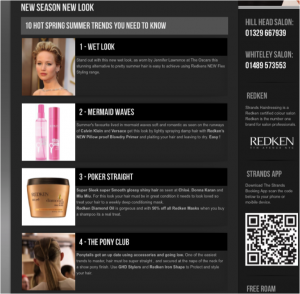
The purpose can be to document the latest trends that can be based on certain themes, such as; seasons, make-up, hair. You could especially theme this around any sponsored products your salon might have, like the example above (with Redken)… As well as where you can buy the products (preferably via your site in a clickable and embedded link) to purchase any products you may sell, and to ultimately get customers to make a booking for an appointment at your salon.
Whilst browsing online, I found a really interesting concept, I’d never seen whilst viewing an online newsletter before. Halo (2015) requests you like their social media sites (Facebook and Twitter) prior to viewing their content. This is a really intuitive way of not only getting your content out to new and existing customer, but to also increase your social media presence as-well. Killing 2 birds with 1 stone. View the full example here and view the screenshot below.

However, I signed-up to receive Rush’s email newsletter, and even-though I haven’t received the newsletter through as-of-yet, the below example shows the importance of following up with your customers after they sign-up to your newsletter and welcoming them to your business and their offerings. Rush entices their customers, by giving them an insight into the type of content they will receive, e.g. news articles, exclusive offers/discounts, hair advice and tips, news and fashion trends, as well as visible links to their social media sites. The example also includes CTA’s to find your local salon, which shows a degree of interactivity and personalisation for customers, to directly engage with the email – even with this as a welcome email.
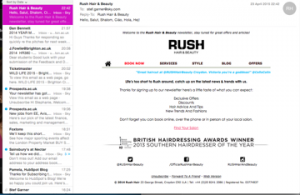
What I think is particularly well done with this example, is their attention grabbing subject line, which is all inclusive (with the inclusion of different languages, displaying a very friendly and inviting tone), which has an optimal display on my mobile device. As well as the opening sentence that summarises the email correctly and informatively. This is something small businesses should consider, how a newsletter, and even the welcome email is read and summarised on different devices. Which may require you to consider what is the key message you want to include as the initial form of correspondence.
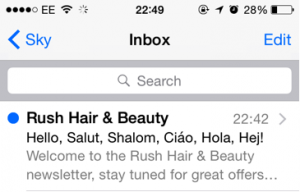
If you want further information, to make your newsletter even more effective, visit my other blogs tailored for small businesses, on; subject lines, the benefits of email marketing, email frequency, tone and personalisation.
References
Constant Contact (2015) Create professional emails. [Online] <http://www.constantcontact.com/features/newsletters-templates> [accessed 24 April 2015]
Halo (2015) Halo Hair & Beauty Newsletter – Jan 2015 edition. [Online] <http://us2.campaign-archive1.com/?u=db1f1dd80ea2d63248733e2db&id=180e74a5df> [accessed 22 April 2015]
HubSpot (2014) How to create email newsletters that don’t suck. [Online] <http://offers.hubspot.com/email-newsletters-that-dont-suck> [accessed 23 April 2015]
Strands Hairdressing (2015) 10 hot spring summer trends you need to know. [Online] < http://www.strands-hairdressing.co.uk/strands-news/archive-newsletters/summer-trends/> [accessed 23 April 2015]
Taken-Smith, K. (2010) ‘Digital marketing strategies that Millennials find appealing, motivating, or just annoying’. Journal of Strategic Marketing, [Online] Vol. 19 (Issue 6)
 Previously in one of my blogs I made reference to an email I had received from DropBox (in my personalisation blog post), which I believe striked the right tone. It was an excellent example of how companies should address their customers, in a mutually beneficial way that enticed me as a customer, without appearing too pushy or obvious.
Previously in one of my blogs I made reference to an email I had received from DropBox (in my personalisation blog post), which I believe striked the right tone. It was an excellent example of how companies should address their customers, in a mutually beneficial way that enticed me as a customer, without appearing too pushy or obvious.
Here is the example again, and why I thought it was great (picture below)…

- It used my name I had signed up with ‘Stephanie’, as a direct way of capturing my attention that the email was personalised for ‘my eyes only’
- It showcased how to use email personalisation in a mutually beneficial way for DropBox and the user (me), by re-stating the benefits to me, with the hope that this would trigger a behavioural response so that I would once again re-use the service provided (to boost engagement)
- Dropbox’s ability to individually monitor its users
- The email is visually appealing (with minimal text, relevant, yet simple use of images)
The tone is highly effective by adopting an informal and conversational stance, by personifying my dropbox account, stating that it is ‘feeling lonely’ with an emotion ‘:-(‘… This made me want to engage with the content and act upon it.
This example then got me thinking… How can businesses strike the right tone in an email, without sounding too salesy or pushy, thus alienating their customers?… Is there a way for businesses to do this?
The right tone of voice is key to establishing a businesses and the way customers view the business. According to Cummings (2015) a tone of voice is… ‘’not what you say, but how you say it. This encompasses not only the words you choose, but their order, rhythm and pace. Rather confusingly, when seen in the world of business and marketing, the phrase ‘tone of voice’ refers to written – rather than spoken – words. A company’s tone of voice will inform all of its written copy, including its website, social media messages, emails and packaging’’.
Email marketing usually involves using email to send ads, request business, or solicit sales or donations, and is meant to build loyalty, trust, or brand awareness (Mohammadi, Malekian, Nosrati, & Karimi, 2013). But this can all be CHANGED if the tone is wrong. Email marketing, should display a ‘good customer service tone’; by not appearing too pushy or sales focused, with the ultimate aim of building a relationship over time… Emails should be sent to gently ‘remind’ customers of the product or behaviour (Mohammadi, Malekian, Nosrati, & Karimi, 2013). You can also use a blend of soft sale and CTA’s in a single email; e.g., if a customer registered on-site and didn’t return (e.g the Gym email example I mentioned in my email frequency blog post) and ask if they need assistance or encountered a problem, whilst still placing a CTA in an email (Mohammadi, Malekian, Nosrati, & Karimi, 2013).

Newsletters play a large role in keeping constant contact with customers, as part of an email marketing initiative. McGraw (2015) has pin-pointed, depending on the type of company, what type of tone is appropriate and when for business, whether the company is creative or corporate. To read more click this link. McGraw (2015) suggests that small businesses should adopt a casual tone, which is more formal than being ‘conversational’ and not as stuffy as a ‘formal’ approach.
Customers like to know that companies have emailed them because they are a valuable customer, rather than one belonging to a mass of customers. A way in which this can be achieved is by writing in second person. According to Wish Pond (2015) by using words such as ‘’you’’, ‘’me’’ and ‘’us’’ this immediately creates a friendly and inviting tone. As well as this Mohammadi, Malekian, Nosrati, & Karimi (2013) suggest that businesses must adopt a gentle tone, as known as a ‘soft sale’ approach, which are read like a customer service- orientated message. For example, asking the customer if he or she experienced a problem you can assist with is a great way to open lines of communication with a customer who has not logged into his/her account, or made a purchase for some time… much like the corrospondance I received from DropBox. It is also a positive tone to use when re-marketing to a cart abandoner.
It is further suggested by many practitioners that communicating in a B2C format, should use plain language, that is easily digestible and ‘human’. It can be tempting to make things sound more sophisticated than they really are, but the key is to speak to people in a way that makes it easier for them to understand what you’re saying (Grauer, 2013). This creates trust with customers.
When using a casual tone, communication will typically appear to be conversational that usually ignores the traditional use of punctuation, a blogy example is… “Well friends, let me tell ya. The holidays were straight. up. crazy. Ugh! Sorry things went dark on the blog for a while, but I needed a breather. Thrilled to be back, though, and eager to start the New Year with all of you.”
Why this example is positive:
– Acknowledges the audience as ‘friends’ which is friendly and encouraging
– Successfully creates an informal and conversational tone
– Correct tone for the personal blogging platform
However, in saying this. It can be difficult to strike a balance between being friendly and too casual in a communicational or informal casual tone. Grauer (2013) states, that “it’s not a matter of being casual just for the heck of it… It’s speaking in a way that resonates with your audience”. It is therefore useful to seek feedback from customers, to determine whether the tone is being received in a positive way by your audience, and that the messages are resonating and not alienating audiences. This san be achieved through qualitative feedback and email marketing metrics by Vertical Response (Popick, 2013).
Whereas, in a B2B format, it may be more appropriate to use industry jargon, so that businesses appear knowledgable and professional to other businesses.
In every individual business case a company’s tone needs to be inline with their overall strategy and offering, especially when communicating to customers.
Ownings (2012) suggests 4 considerations for ‘finding the right tone’’
1.) Consider your company culture
2.) Don’t be overly familiar
3.) Don’t have multiple personalities
4.) Write like you mean it!
In summary, for small businesses looking to develop their own individual ‘tone’ in email marketing correspondence, they will need to write: in second person, plain easy to understand language, in a customer service orientated tone, and a tone that is consistent with the company and it’s strategy and in a casual tone, that is inviting and friendly.
For a more detailed insight into this topic, visit authors Harriet Cummings work to ”Find your brands voice: How to shape a tone of voice”.
References
Bunskoek, K. (2015) 8 steps to write email copy that converts. Wish Pond [Online] <http://blog.wishpond.com/post/67669286364/8-steps-to-write-email-copy-that-converts> [accessed 12 April 2015]
Cummings, H. (2015) Find your brands voice: How to shape a tone of voice. Distilled [Online] <https://www.distilled.net/tone-of-voice/> [accessed 12 April 2015]
Grauer, Y. (2013) Getting your company’s voice right. Vertical Response [Online] <http://sumo.ly/6gi4> [accessed 13 April 2015]
McGraw, S. (2015) Watch Your Tone: The Importance of Voice in Newsletter Communications. Mad Mimi [Online] <http://blog.madmimi.com/tone-newsletter-communications/> [accessed 12 April 2015]
Mohammadi, M., Malekian, K., Nosrati, M., & Karimi, R. (2013). Email Marketing as a Popular Type of Small Business Advertisement: A Short Review. Australian Journal of Basic and Applied Sciences. Vol. 7 (Issue 4), p786-790
Ownings, P. (2012) Find your tone to increase email marketing conversion. Inbound Marketing [Online] <http://www.inboundmarketingagents.com/inbound-marketing-agents-blog/bid/197191/Find-Your-Tone-to-Increase-Email-Marketing-Conversion> [accessed 12 April 2015]
Popick, J. (2013) 5 metrics every marketer needs to keep an eye on. Vertical Response [Online] <http://www.verticalresponse.com/blog/5-metrics-every-marketer-needs-to-keep-an-eye-on/> [accessed 13 April 2015]
 or
or 
Frequency of sending emails is an important part of building customer relationships: too many might irritate and too few could lose the recipient’s interest (Ellis-Chadwick & Doherty, 2012). This fine line is hard for emarketers to comprehend.
Relationships between customers are crucial for companies to maintain, as its all about trust. However, the amount of emails a company sends can cause customers to become dissatisfied, leading to a break in trust and relationship.
I signed up to Reed a couple of months ago to assist on my graduate job search. But since signing-up I receive what seems like endless emails from them. From the picture below you can see that I receive 1 email a day, without fail! The reason I haven’t unsubscribed is because I’m hoping that one day an email will prove relevant and beneficial to me.
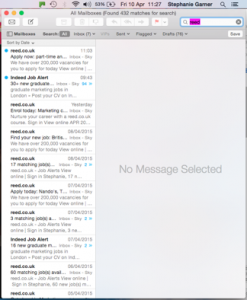
However, this does not take away from the fact that I find the frequency of these emails extremely irritating. Moth (2014) argues that it’s not about sending more or less emails to customers, its about sending the right amount of emails to the right people. But, how much is too much?
HubSpot proposes a 5-step test to determine optimal email frequency specifically for an individual company, detailed below and more information is provided in the embedded link
1.) Establish a hypotheses
2.) Choose a list segment
3.) Establish baseline metrics
4.) Create and schedule test emails
5.) Measure and analyse results
There is a lot of research, both practitioner and academic, surrounding email frequency to sustain and maintain the relationship between customers and businesses. From a practitioner perspective, Alchemy Worx (2013) states that 60% of customers received less than 6 emails per day from trusted brands, of which 40% received 3 or less. However too much frequency can cause customers to unsubscribe (image below) (Moth, 2014). Mail Chimp (2013), further supports this fact, by stating that if ‘frequency goes up, engagement goes down’.

However, Moth (2014) suggests that email frequency should be based upon online engagement and purchase history. Reinforcing that its about sending the right amount of emails to the right people, as depicted in the image below.
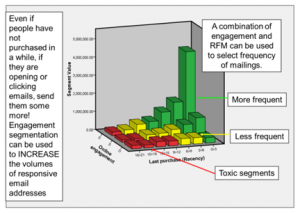
Ellis-Chadwick and Doherty (2012) conducted a study into email marketing, where an electronic archive was set up to ensure that all the emails were stored in a consistent and secure manner. Over this period, 20 retailers posted nearly 1,000 separate emails, with the most active retailer sending 113 messages, which equates to one email every 5 days, on average.
Mohammadi, Malekian, Nosrati, & Karimi (2013) suggest that businesses should email customers in a 3 pronged way. Firstly, an email should immediately follow-up after a behaviour trigger or customer action, accompanied with a good customer service tone. I found an example of this in my emails just the other day. It came after I began signing up for a gym membership, and then decided to leave the page. 20 minutes after I then received a follow-up email, which then prompted me to complete my membership registration.

Mohammadi, Malekian, Nosrati, & Karimi (2013) suggest that for the 2nd and 3rd follow-up these should come a day or 2 after, and in a weeks time. These automated trigger emails help remain businesses focused on building relationships over time.
Although there are differences in opinion regarding recommended email frequency, Moth (2014) suggests that the businesses need to segment their audience, and to test sending messages (through open and clickthrough rates) so that messages are tailored to customer behaviour, to ensure relationships are maintained without alienating customers .
Hynek (2014) reportedly has found the ‘sweet spot’ for the ideal frequency to engage customers. Sending an email every 2 weeks is the frequency best received by customers, without ‘burning out’ subscriber lists or alienating customers.
However, all of this being said, it is more acceptable to increase email frequency in the lead-up to Christmas periods (Charlton, 2013).
References
Alchemy Worx (2013) Debunking the 7 myths of email marketing – Infographic [Online] <http://www.alchemyworx.com/emailworx/2013/strategy/subject-lines/debunking-the-7-myths-of-email-marketing-–-infographic> [accessed 1 March 2015]
Charlton, G. (2013) 30+ christmas email marketing tips from the experts. Econsultancy [Online] <https://econsultancy.com/blog/63714-30-christmas-email-marketing-tips-from-the-experts> [accessed 9 April 2015]
Ellis-Chadwick, F., & Doherty, N. F. (2012) Web advertising: The role of e-mail marketing. Journal of Business Research. Vol. 65, No. 6, p843-848
Eridon, C. (2011) The 5-step test to determine optimal email frequency. Hub Spot [Online] <http://blog.hubspot.com/blog/tabid/6307/bid/30302/The-5-Step-Test-to-Determine-Optimal-Email-Frequency.aspx> [accessed 10 April 2015]
Hynek, A. (2014) The ideal email frequency. Campaign Monitor [Online] <https://www.campaignmonitor.com/blog/post/4154/the-ideal-email-frequency> [accessed 9 April 2015]
Mail Chimp (2013) Sending frequency: More is not always better! [Online] < http://blog.mailchimp.com/sending-frequency-more-is-not-always-better/> [accessed 9 April 2015]
Mohammadi, M., Malekian, K., Nosrati, M., & Karimi, R. (2013). Email Marketing as a Popular Type of Small Business Advertisement: A Short Review. Australian Journal of Basic and Applied Sciences. Vol. 7 (Issue 4), p786-790
Moth, D. (2014) Email frequency: How much is too much? Econsultancy [Online] <https://econsultancy.com/blog/64165-email-frequency-how-much-is-too-much/> [accessed 9 April 2015]
But, first… what is E-mail Marketing and Social Media?
 Vs.
Vs. 
Email Marketing
E-mail is a direct form of permission-based CRM (customer relationship management) within marketing that enables a message(s) to be sent to a group of potential or existing customers via email, in order to start a conversation and or relationship between the company and customers (Social Media Today, 2014).
Social media
According to Oxford Dictionaries (2015) social media is; websites and applications that enable users to create and share content or to participate in social networking. These websites and applications include (to name a few): Twitter; Facebook; Pintrest; Linkedin and YouTube.
Benefits of Email to Businesses…
Often email marketing is overlooked due to the fine line between effective email marketing and spam marketing, the perceived demise of email as an effective way of reaching customers as well as common misconceptions from Alchemy Worx (2014). However, email marketing is actually considered to be the most effective online-channel for ROI (return on investment) (Charlton, 2014: Littlechild, 2014). Emails create impressions that lead to sales through other routes from the email (Middleton-Hughes, 2012) and are useful at telling companies the digital story of the customers, and as a result 85% of marketers cite email as the most effective lead-generation tactic (Social Media Today, 2014).
Ratings for the best digital channels of ROI
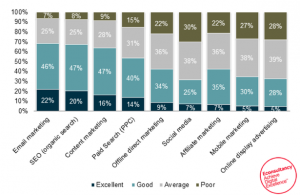 Source: Charlton (2014)
Source: Charlton (2014)
Attention has been taken away from the more traditional approach of email marketing, as companies adhere to the rise of social media with the digital revolution. However, often there is a considerable lack of understanding of social media according to DeMers (2014). Even so, social media has been shown to have positive effects on perceived brand recognition, brand loyalty and an improvement of the overall customer experience. Email, though, is said to improve customer communications and loyalty long-term (Bustos, 2015).
Email has always been a simple, easy to use and non-glamorous marketing tool. In fact, the rise of social media has largely built on the email experience by adding more features and offering more interactivity (Idugboe, 2015). But still you might be thinking… is email dead?
 … Click here to view the infographic in full, and more information on the role/importance of email…
… Click here to view the infographic in full, and more information on the role/importance of email…
No! Email is still king (Middleton-Hughes, 2012) and, is not dead!
A study conducted showed that email marketing is intended to receive the most spending from emarketers as the primary source of online marketing: as many as 69% marketing programs indicated a strong preference for email marketing as compared to 59% who opted for social media, as indicated below (Idugboe, 2015).
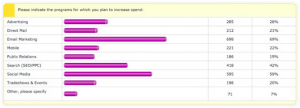
Social Media offers many ways to pursue innovative marketing techniques on a multitude of platforms – online video promotions (YouTube), audio podcasts, Fan Pages (Facebook), tweets and pins (Twitter and Pintrest). It allows companies to reach out to a large number of people on different networks in different walks of life.
However, in saying this, for small companies, with limited resources, email marketing is the way to go. Although there are no costs associated with purchasing and running social media per se, it costs companies to hire or require employees to continually monitor their associated social media sites, which impacts on time and financial restraints (Mohammadi, Malekian, Nosrati, & Karimi, 2013). On the other hand, businesses can set-up email host suites that ping out emails on a regular basis/occasion, this also allows emails to be measurable through analytical programmes via: bounce, delivery, click and conversion rates (Rospigliosi, 2014).
Email marketing as a whole is generally a less taxing process than social media maintenance, with less responsibility (Idugboe, 2015) low set-up costs (Ellis-Chadwick & Doherty, 2012), and has flexibility across platforms (Rospigliosi, 2014), which makes it quick and easy for small businesses to implement. However, despite these benefits ‘businesses are slow to adopt to email marketing practises’, and mistakenly are intimidated by the phrase ’email marketing’ itself (Mohammadi, Malekian, Nosrati, & Karimi, 2013) due to the perception of needing to be a digital marketing expert to implement an email marketing campaign.
The overall customer experience is better for customers with email marketing due to the fact that it is able to provide easy individual personalisation and interactivity (that often invites immediate respond action) (Rospigliosi, 2014; Ellis-Chadwick & Doherty, 2012).
As well as these benefits, email is ranked as the #1 communication channel by consumers for initial introduction to a product/service, learning about a product/service, and post-purchase follow-up about a product/service. This leads to higher conversion rates (at least 3x as high as social media conversion rates) (Social Media Today, 2014), and it is generally easier to keep storable information on customers (for CRM databases) than from social media sites, due to its data driven nature, which also allows emails to be highly focused and targeted as a result (Amprewave Media, 2015: Shout it out Design, 2015; Rospigliosi, 2014).
Email offers greater exposure than other channels, such as social media, as it waits in the inbox, and has higher exposure than blogs and social media platforms (Amprewave Media, 2015).
However, like anything, email marketing also has its downfalls…
The frequency of emails is a topic that always arises – messages that are too frequent can be deemed annoying, which can prove hard for marketeers to know exactly when to send their emails and also lead customers to believe that an email is ‘spam’ (Savvy SME, 2013), which can subsequently affect companies website rankings and reputation amongst customers. Email marketing often can disengage readers, leading to un-subscriptions and the risk of ultimately alienating any remaining customers (Savvy SME, 2013). However, emails are often deleted before being opened, therefore reducing the opportunity to gain new customers (Email Lists, 2011).
However, despite email being a superior channel, social media and email marketing can work hand-in-hand in an integrated way. Many referral campaigns and incentive-based promotions have benefited from the combo of Email + Social Media Marketing (Rospigliosi, 2014; Idugboe, 2015).
In any case, email marketing is trial and error process, the advantages and disadvantages will only be truly applicable if research is conducted on the audience and tested for success or failure through A and B testing. Take a look at this beginners site to understand the testing and the impact on conversion rates – http://bit.ly/1Oagyxw.
References
Alchemy Worx (2013) Debunking the 7 myths of email marketing – Infographic [Online] <http://www.alchemyworx.com/emailworx/2013/strategy/subject-lines/debunking-the-7-myths-of-email-marketing-–-infographic> [accessed 1 March 2015]
Amprewave Media (2015) Build your audience with email marketing [Online] <http://www.amprewave.com/content-marketing/build-your-audience-with-email-marketing/> [accessed 2 February 2015]
Charlton, G. (2014) ‘Email remains the best digital channel for ROI’. Econsultancy, 31 March 2014. [Online] <https://econsultancy.com/blog/64614-email-remains-the-best-digital-channel-for-roi/> [accessed 20 January 2015]
DeMers, J. (2014) ‘The top 10 benefits of social media marketing’. Forbes. 8 November 2014 [Online] <http://www.forbes.com/sites/jaysondemers/2014/08/11/the-top-10-benefits-of-social-media-marketing/> [accessed 2 March 2015]
Ellis-Chadwick, F., & Doherty, N. F. (2012) Web advertising: The role of e-mail marketing. Journal of Business Research. Vol. 65, No. 6, p843-848
Email Lists (2011) Email marketing: Advantages and disadvantages [Online] <http://email-lists1.com/email-marketing-advantages-and-disadvantages.html> [accessed 12 February 2015]
Idugboe, D. (2015) Why you shouldn’t abandon email marketing for social media. Smedio [Online] <http://www.smedio.com/why-social-media-is-yet-to-destroy-email-marketing/> [accessed 2 March 2015]
Kiss Metrics (2105) A beginner’s guide to A/B testing: Email campaigns that convert [Online] <https://blog.kissmetrics.com/ab-testing-email-campaigns/> [accessed 2 March 2015]
Littlechild, D. (2014) ‘Email marketing best practise guide’. Econsultancy. 14 March 2014 [Online] <https://econsultancy.com/reports/email-marketing-best-practice-guide> [accessed 12 February 2015]
Middleton-Hughes, A. (2012) ‘Why email marketing is king.’ Harvard Business Review. 9 August 2012 <https://hbr.org/2012/08/why-email-marketing-is-king> [accessed 9 February 2015]
Mohammadi, M., Malekian, K., Nosrati, M., & Karimi, R. (2013). Email Marketing as a Popular Type of Small Business Advertisement: A Short Review. Australian Journal of Basic and Applied Sciences. Vol. 7 (Issue 4), p786-790
Oxford Dictionaries (2015) Definition of social media [Online] <http://www.oxforddictionaries.com/definition/english/social-media> [accessed 2 March 2015]
Rospigliosi, A. (2014) ‘Email Marketing’ [Lecture notes] Brighton: University of Brighton Business School, unpublished
Savvy SME (2013) What are the advantages and disadvantages of email marketing? [Online] <https://www.savvysme.com.au/article/8-what-are-the-advantages-and-disadvantages-of-email-marketing> [accessed 10 January 2015]
Small Business (2015) Advantages and disadvantages of email marketing [Online] <http://smallbusiness.chron.com/advantages-disadvantages-email-marketing-3475.html> [accessed 14 January 2015]
Shout it out Design (2015) Top 10 advantages of email marketing [Online] <http://shoutitoutdesign.com/top-10-advantages-of-email-marketing/> [accessed 25 January 2015]
Social Media Today (2014) Attraction 101: Content marketing [e-book] Available at <http://www.socialmediatoday.com/sites/default/files/ebook_pdfs/actonebook-attraction101-dec2014.pdf> [accessed 12 January 2015]
 The number of emails I receive daily can range from 10-50, from daily deals to newsletters. Yet, I always have an internal debate with myself as to whether I open or delete these emails, and I think to myself…
The number of emails I receive daily can range from 10-50, from daily deals to newsletters. Yet, I always have an internal debate with myself as to whether I open or delete these emails, and I think to myself…
- Does the email entice me?
- Will the email offer me some added value?
But, what makes me decide to do so for each email?.. Simple – Subject lines!
It is email marketers’ jobs to provide readers with an enticing insight into an email’s content, whilst giving the reader an impression as to what the email is about. The subject line acts as a ‘window’ to the email and is arguably the single most important part, to determine whether the e-mail is to, or not to be opened, which is used by 100% of businesses (Ellis-Chadwick and Doherty, 2012) – with the need to have a consistent link between the subject line and email content.
Subject lines in the e-mail are the first point of contact for readers, and acts as a trigger to encourage the message recipient to open the email. There are 2 main components in the subject line: e-mail sender and e-mail content (Ellis-Chadwick and Doherty, 2012).
But first – how to write an email subject line?..
16 tips to writing an email subject line (Goudreau, 2015):
- Always write a subject line.
- Write the subject line first.
- Keep it short.
- Place the most important words at the beginning.
- Eliminate filler words.
- Be clear and specific about the topic of the email.
- Keep it simple and focused.
- Use logical keywords for search and filtering.
- Indicate if you need a response.
- Set a deadline in the subject line.
- If someone referred you, be sure to use their name.
- Highlight the value you have to offer.
- Personalize it with the recipient’s name or company name.
- Create urgency by limiting the timeframe.
- Don’t start a sentence that you finish in the email’s body.
- Make sure you reread the subject line.
Below also indicates what you should and shouldn’t do/include in your subject lines.
What to do…
Here are 10 great examples from Hubspot (2015) to document the ways in which email subject lines can attract attention.
10 Examples of subject lines and why they’re good
| Company |
E-Mail subject line |
Why the examples are good |
| 1.) Warby Parker |
“Uh-oh, your prescription is expiring” |
Timing, correct tone and informal |
| 2.) Groupon |
“Best of Groupon: The Deals That Make Us Proud (Unlike Our Nephew, Steve)” |
Humour (unexpected) |
| 3.) Rent the Runway |
“Happy Birthday Lindsay – Surprise Inside!” |
Personalisation, offer eludes to an incentive (added value) |
| 4.) Barack Obama |
“Hey” |
Informal (over familiar language) offers intruige, unlikely subject line and sender pairing |
| 5.) Manicube |
“*Don’t Open This Email*” |
Curiosity |
| 6.) Refinery29 |
“The broke girl’s guide to a luxury vacation” |
Self-identification |
| 7.) Zillow |
“What Can You Afford?” |
Playing off physical emotions |
| 8.) UncommonGoods |
“As You Wish” |
Thinking about what makes people tick |
| 9.) DocuSign |
“What are our customers saying?” |
Relevant facts for customers |
| 10.) Eater Boston |
“Where to Drink Beer Right Now” |
Timing (sent at 6:45pm) – engagement |
These subject lines appeal to audiences through the use of questions to directly engage with readers, offering them a way to stop and think about what is being asked, a conversational and informal stance, offering added value, personalisation and humour. Hubspot (2015) further suggest that principles like urgency, scarcity, and social proof are all also great ways to increase conversion rates.
Ellis-Chadwick and Doherty (2012) found that more than 56% of emails sent by businesses, offered an incentive in the subject line, predominately based upon a discount or saving (28% of the emails) and occasion or seasonal promotions (10%). Furthering from this, they also found that 44% of marketing emails offered no incentive in the subject line, which were most commonly newsletters, product information, or ‘teaser’ messages about forthcoming new products.
What not to do…
However, it is very easy to get subject lines wrong.
|
Words to be avoided within subject lines
|
| Number |
Words / Examples |
Justification |
| 1 |
Free |
Triggers spam filters, but ‘free delivery’ has been shown to drive response uplifts |
| 2 |
Help, % off, reminder |
Regularly discarded |
| 3 |
Save today, don’t miss |
Does not entice readers to open emails |
| 4 |
Holiday sales event |
Too ‘salesy’, instead use promotion or newsletter |
| 5 |
FWD: and RE: |
Deceptively enticing customers to think communication has already been established |
| 6 |
NEW OFFER |
Writing in capitals, is too harsh and direct as an approach |
| 7 |
Hello Chris… (sent to Tom) |
Personalisation data has to be correct, and doesn’t always result in open-rates |
| 8 |
🙂 !!! … [ ] < > <3 |
Unnecessary use of punctuation or emoticons |
| Source: Compiled by author, information from Ratcliff, C (2014) |
The purpose of the table is to demonstrate that customers value straightforwardness and that subject lines must be relevant and enticing, and should be used 100% of the time according to Ellis-Chadwick and Doherty (2012).
I received an email the other day, which included an emoticon in the subject line, which can be seen below. Immediately I didn’t open the email as I could tell it was a spam email and one which I wouldn’t be interested in, especially due to the unnecessary heart included, which is a ‘no-no’ according to Ratcliff (2014). The email also tried to entice me in by having the senders name as a first name, trying to suggest that I have had some prior correspondence with the sender, lulling me into a false sense of security, in an attempt at personalisation. This was a clever move by the sender, but was an immoral way of sending emails.

Subject lines are critical for engagement and grabbing attention of readers (Ellis-Chadwick and Doherty, 2012). However, subject lines need to be tested as different triggers or language may work for different audiences, as well as for different purposes.
Ellis-Chadwick and Doherty (2012) suggest that using variant testing should be used to determine effective subject lines, by understanding what will engage the customer most, via looking at the greatest open rates.
Common misconceptions about email marketing from Alchemy Worx (2013) state that key words have little or no effect on the subject line ending up in the junk folder according to 54bn sent emails, and shorter email subject lines do not give better results under 60 characters.
Ellis-Chadwick and Doherty (2012) summarise the importance of subject line… ‘Subject lines MUST grab the initial attention of the customer and prompt him or her to open the email; otherwise, there is no opportunity for sustained attention; the message can be deleted and never seen again, unlike print media messages, which can be returned to later’.
References
Alchemy Worx (2013) Debunking the 7 myths of email marketing – Infographic [Online] <http://www.alchemyworx.com/emailworx/2013/strategy/subject-lines/debunking-the-7-myths-of-email-marketing-–-infographic> [accessed 1 April 2015]
Ellis-Chadwick, F., & Doherty, N. F. (2012) Web advertising: The role of e-mail marketing. Journal of Business Research, Vol. 65 (Issue 6), p843-848
Goudreau, J. (2015) 17 tips for writing an excellent email subject line. Business Insider UK [Online] <http://uk.businessinsider.com/how-to-write-an-email-subject-line-2015-1> [accessed 1 April 2015]
Ratcliff, C (2014) 45 words to avoid in your email marketing subject lines. Consultancy [Online] <https://econsultancy.com/blog/64878-45-words-to-avoid-in-your-email-marketing-subject-lines> [accessed 1 April 2015]
Soskey, G (2015) 18 of the best email subject lines you’ve ever read. Hubspot. [Online] <http://blog.hubspot.com/marketing/best-email-subject-lines-list> [accessed 1 April 2015]

Truly personal brand experiences have become a desirable commodity for users, cutting through the cyber babble and striking a chord with target customers, who want to be treated as an individual, by quickly receiving content they want (The Marketer, 2012).
Personalised relationships, are arguably the most important benefit for any sized business using digital media (Taken-Smith, 2011), and have been shown to increase the level of loyalty a customers (Srinivasan, Anderson & Ponnavolu, 2002).
Email is often a common and direct form of targeting customers: especially Generation Y, which can be personalised through: automated triggers, for example using the name of the recipient in the subject line, or opening line to the email content, as well as personalising content to their preferences and previous shopping habits with the host site, tracked by data. The main objectives of personalisation is to build customer relationships and to make communication relevant to the customer so they can relate to the content of the email marketing message (Mohammadi, Malekian, Nosrati, & Karimi, 2013).
This being said, I rarely get e-mails that are personalised with my name or to my interests. I receive an average of 25 emails a day, all of which are mundane junk, that have no relevance to my life or spark my interest. I’m part of Generation Y, who according to Taken-Smith (2011) respond to personalised messages and are an extremely savvy generation, as such, I generally delete these emails without reading or clicking through to the content.
The other day, I signed up to receive Aston Martin’s newsletter (because who doesn’t like to look at nice cars once in a while?!) I was excited to receive my first correspondence from Aston Martin (below), promptly after signing up to their newsletter on their site. But, I found myself disappointed by their sloppy and fairly basic attempt at personalisation, showing that even well-known brands get it wrong.
As part of the newsletter sign-up process, I was required to fill in my name, so I was surprised to see that the email I received, where my name should be, was left blank (indicated by the -). Personalisation is directly linked with how good a company is at gathering accurate data. Aston Martin should have had set up a rule in their data that if the name was blank then personalisation wouldn’t be included, but they haven’t, and it makes them look silly. Therefore, this simple mistake ruined the ‘luxury’ image I had of the brand, and negatively impacted my opinion of their brand equity. Taken-Smith (2011) states that making Generation Y feel ‘like they are special’ is highly influential, especially for relationship building, sadly this was not fulfilled by Aston Martin.
Aston Martin: Bad Example of Personalisation

PhotoBox: Average Example of Personalisation
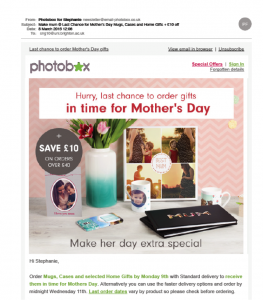
Generation Y are the most demanding of the generations, who expect brands to work for their business, through vouchers and or discounts in order to show them that you care about their business, by sending them deals directly (Durbin, 2014).
This being said, the e-mail I received from PhotoBox, before Mother’s Day, is a great example of how businesses are personalising offers and discounts in order to adhere to Generation Y’s demanding nature. Although, the message incorporates my name, overall it is a very generic message, and has not necessarily been sent to me because I’m Generation Y, but because I recently purchased some discounted photo prints from their website, and therefore is a basic example of personalisation. However, I probably would have clicked through to the offer, if I hadn’t made my recent purchase.
DropBox: Good Example of Personalisation

A while back I received, what I thought was a really good personalised message from Drop Box… for the following reasons:
- It used my name I had signed up with ‘Stephanie’, as a direct way of capturing my attention that the email was personalised for ‘my eyes only’
- It showcased how to use email personalisation in a mutually beneficial way for DropBox and the user (me), by re-stating the benefits to me, with the hope that this would trigger a behavioural response so that I would once again re-use the service provided (to boost engagement)
- Dropbox’s ability to individually monitor its users
- The email is visually appealing (with minimal text, relevant, yet simple use of images)
- The tone is highly effective by adopting an informal and conversational stance, by personifying my dropbox account, stating that it is ‘feeling lonely’ with an emotion ‘:-(‘… made me want to engage with the content and act upon it
Despite showing how effective personalisation can be, by initiating customer behaviours (through offers, incentives and benefits), only 50% of companies are personalising their website experience and emails for their customers, even-though 94% of companies agree that personalisation ‘is critical to current and future success’ according to Durbin (2014). This is predominately due to business, especially small, not having the dedicated work-force to set-up the personalisation process, and who may also view it as a time consuming process, and may not fully understand how to implement a personalised service for customers.
There is also documented evidence from (Taken-Smith, 2011) showing that personalisation captures 46% of Generation Y’s attention, but is not the most effective strategy.
Lack of data a company or business has on their customers, could prove difficult when trying to personalise to individuals. Besides the fact that ‘personalisation is key’… Personalisation, according to Paul Phillips (Davey, 2014), technical director at Information Builders, is: “an incredibly data intensive task; both combining detailed, historical data and adding future, predictive insight. You need to be combining real-time data from a number of sources (such as GPS location, pages visited, products viewed, etc.) and combining this with an immense amount of background and historic data (such as previous transaction records or demographic detail) that provides additional context. Businesses need to be able to master the balance of live and contextual data to begin to make the most of personalisation.”
As such, a couple of links have been provided below, to offer more insight into personalisation….
How to start personalisation, top-tips
To create a personalised relationship with customers, the following steps by Digital Doughnut (2013) should be taken:
- Greet readers by their first names
- Speak to each reader as if they are your only reader
- Think conversation. Not self-promotion
- Tailor your emails for each recipient
… and to view a step-by-step guide of how to personalise your emails, visit view Hubspots’ blog (2014)
… and, for some inspiration, visit their (Hubspots, 2013) 7 excellent examples of email personalisation in action.
References
Davey, N. (2014) Personalisation is possible – so why are few brands doing it well? MyCustomer [Online] <http://www.mycustomer.com/feature/experience-marketing/personalisation-possible-so-why-are-so-few-brands-doing-it-well/167901> [accessed 1 March 2015]
Digital Doughnut (2013) 4 tips to improve your email marketing with personalisation. [Online] <http://www.digitaldoughnut.com/feeds/feeds/4-tips-to-improve-your-email-marketing-with-personalisation> [accessed 1 March 2015]
Durbin, R. (2014) The importance of data personalisation and localisation. Econsultancy [Online] <https://econsultancy.com/blog/64438-the-importance-of-data-personalisation-and-localisation/> [accessed 27 February 2015]
Hubspot (2014) How to personalise your emails. [Online]<http://knowledge.hubspot.com/email-user-guide/how-to-personalize-your-emails> [accessed 1 March 2015]
Hubspot (2013) 7 excellent examples of email personalisation in action. [Online] <http://blog.hubspot.com/blog/tabid/6307/bid/34146/7-Excellent-Examples-of-Email-Personalization-in-Action.aspx> [accessed 27 February 2015]
Mohammadi, M., Malekian, K., Nosrati, M., & Karimi, R. (2013) Email Marketing as a Popular Type of Small Business Advertisement: A Short Review. Australian Journal of Basic and Applied Sciences. Vol. 7 (Issue 4) p786-790
Srinivasan, S., Anderson, R. & Ponnavolu, K. (2002) ‘Customer loyalty in e-commerce: An exploration of its antecedents and consequences’. Journal of Retailing, [Online] Vol. 78 (Issue 1) < ‘http://connection.ebscohost.com/c/articles/12130375/customer-loyalty-e-commerce-exploration-antecedents-consequences > [accessed 25 February 2015]
Taken-Smith, K. (2011) ‘Digital marketing strategies that Millennials find appealing, motivating, or just annoying’. Journal of Strategic Marketing, [Online] Vol. 19 (Issue 6)<http://www.tandfonline.com/doi/abs/10.1080/0965254X.2011.581383?journalCode=rjsm20#.VRsTaUIbI3Y> [accessed 25 February 2015]
The Marketer (2012) The personal touch: why personalised marketing matters. The Marketer. 22 August 2012. [Online] <http://www.themarketer.co.uk/archives/trends/personalised-marketing/> [accessed 20 February 2015]
Are you a small business and looking for ways to increase your visibility (online) and drive more sales?
Why not consider the role of E-mail Marketing?

But, first… what is E-mail Marketing?
E-mail is a direct form of permission based CRM (customer relationship management) within marketing, that enables a message(s) to be sent to a group of potential or existing customers via email, in order to start a conversation and or relationship between the company and customers (Social Media Today, 2014).
Although, you might consider E-mail Marketing to be ‘a thing of the past’ and an out-dated medium of direct communication, it is considered to be the most effective online-channel for ROI (return on investment) (Charlton, 2014: Littlechild, 2014). E-mails create impressions that lead to sales through other routes from the E-mail (Middleton-Hughes, 2012), and are useful at telling companies the story customers make digitally and as a result 85% of marketers cite E-mail as the most effective lead-generation tactic (Social Media Today, 2014).
Ratings for the best digital channels of ROI

Source: Charlton (2014)
But still you might be thinking ‘’WHY should I even consider E-mail as a channel?’’
Well… E-mail Marketing has a multitude of benefits when marketing to both B2B and B2C audiences.
15 Benefits of E-mail Marketing:
- Low set-ups costs (Ellis-Chadwick & Doherty, 2010)
- Flexible across platforms (Rospigliosi, 2014)
- Fast campaign deployment (Rospigliosi, 2014)
- Measurable, through analytical programmes via bounce, delivery, click and conversion rates (Rospigliosi, 2014)
- Data driven (Rospigliosi, 2014)
- Integration with other media (such as social media) (Rospigliosi, 2014)
- E-mails offers great exposures than other channels, as it waits in the inbox, and has higher exposure than blogs and social media platforms (Amprewave Media, 2015)
- E-mail is highly focused and targeted (Amprewave Media, 2015: Shout it out Design, 2015)
- ROI of 4,300% (Social Media Today, 2014)
- Improves customer communications and loyalty (Bustos, 2015)
- Ability to drive high levels of traffic and conversion (into sales) (Rospigliosi, 2014)
- Interactivity (that often invites immediate respond action) (Rospigliosi, 2014)
- Easily personalised (Ellis-Chadwick & Doherty, 2010)
- E-mail is ranked as the #1 communication channel by consumers for initial introduction to a product/ service, learning about a product/service, and post-purchase follow-up about a product/service (Social Media Today, 2014)
- Leads to higher conversion rates (at least 3X as high as social media conversion rates) (Social Media Today, 2014)
Disadvantages of E-mail Marketing
Although E-mail Marketing has many benefits in potentially aiding your organisation, disadvantages are also associated with E-mails, which is something you need to consider. E-mail Marketing messages can be deemed annoying or too frequent, which can prove hard for marketeers to know exactly when to send their E-mails (which could lead customers to believe your email is ‘spam’ (Savvy SME, 2013), and affect your company’s website rankings and reputation amongst customers).
Other disadvantages include:
- Deliverability, E-mails may not reach the intended audience (Small Business, 2015) sent to spam inbox, or customers addresses change (Savvy SME, 2013)
- E-mails are often deleted before being opened, reducing the opportunity to gain new customers (Email Lists, 2011)
- Design issues, due to different devices and screen sizes can cause any graphics or layouts to appear different
- Response decay (Rospigliosi, 2014)
- Resource intensive (someone would need to write, distribute and assess the out-going E-mails, which would take time to learn) (Rospigliosi, 2014)
- E-mail Marketing often can disengage readers, leading to unsubscribing and alienating remaining customers (Savvy SME, 2013)
However, the above disadvantages can often be avoided through prior planning and learning from previous experiences.
In any case… E-mail Marketing is trial and error process, the advantages and disadvantages will only be truly applicable if research is conducted on the audience and tested for success or failure.
However, as evident in this blog, the positives FAR outweigh the negatives. So, why don’t you start your email marketing today?
…Want to know more about E-mail marketing campaigns? Watch this space for future blog posts…
References
Amprewave Media (2015) Build your audience with email marketing [Online] < http://bit.ly/17vbZy3 > [accessed 2 February 2015]
Charlton, G. (2014) ‘Email remains the best digital channel for ROI’. Econsultancy, 31 March 2014. [Online] < http://bit.ly/19g4D1U > [accessed 20 January 2015]
Ellis-Chadwick, F., & Doherty, N. F. (2012) Web advertising: The role of e-mail marketing. Journal of Business Research. Vol. 65, No. 6, p843-848
Email Lists (2011) Email marketing: Advantages and disadvantages [Online] < http://bit.ly/1uRwlvj > [accessed 12 February 2015]
Littlechild, D. (2014) ‘Email marketing best practise guide’. Econsultancy. 14 March 2014 [Online] < http://bit.ly/1iN9JQl > [accessed 12 February 2015]
Middleton-Hughes, A. (2012) ‘Why email marketing is king.’ Harvard Business Review. 9 August 2012 < http://bit.ly/175hZfB > [accessed 9 February 2015]
Rospigliosi, A. (2014) ‘Email Marketing’ [Lecture notes] Brighton: University of Brighton Business School, unpublished
Savvy SME (2013) What are the advantages and disadvantages of email marketing? [Online] < http://bit.ly/1vs6fdl > [accessed 10 January 2015]
Small Business (2015) Advantages and disadvantages of email marketing [Online] < http://bit.ly/1D0JIcq > [accessed 14 January 2015]
Shout it out Design (2015) Top 10 advantages of email marketing [Online] < http://bit.ly/1CqjONa > [accessed 25 January 2015]
Social Media Today (2014) Attraction 101: Content marketing [e-book] Available at < http://bit.ly/1CtgC4r > [accessed 12 January 2015]
One of the many e-mail I receive daily consist of companies either mailing me with their latest products, offers, or simply re-reminding me of their products or services they have to offer.
The latest corporate communication I recieved consisted of a post-purchase e-mail from Argos, to review my recent purchase with them.
The e-mail offered a form of personalisation, which according to Ellis-Chadwick & Doherty (2012)* improves click-through rates, and therefore caught my attention. When I recieve personalised e-mails I usually presume that the company, communicating via e-mail marketing, are offering me some sort of offer or incentive that I would find appealing in order to make a subsequent purchase.
However, there were no apparent incentives for me to post a review or even spend time filling out the review form (the image below). The only benefit I could see from the landing page, was one that serves the company itself. The review required the reviewer to enter their own personal details, once completing the review, to presumably gather more information on the consumer (me) to be able to further target customers with specific (personalised) products in the future.
https://blogs.brighton.ac.uk/sng10/?p=13
Even a simple recognition of being ‘a valuable customer’ may have sparked my interest in potentially looking at the review page in more detail, or even left a review, if more of a personalised emphasis had been made such as… ‘you are a valuable customer, and we value your opinion’. As such, there were no visable benefits, and a review was not left.
* Ellis-Chadwick, F., & Doherty, N. F. (2012). Web advertising: The role of e-mail marketing. Journal of Business Research, 65(6), 843-848.
This weeks reading of McAfee & Brynjolfsson’s article on ”You can’t manage what you can’t measure”. Offered insight into Big Data, of which they express the importance of why digital data is so important for companies to gain an understanding of their customers/consumers, which can be achieved (or tracked) through the following ways;
– what the customers bought,
– what they looked at,
– how they naviagte through a site,
– how much they are influenced through promotions, reviews and lay outs.
As a result of the above insights, companies have developed algorythums off the back of this.
They futher express that Big Data has the capabilities to transform businesses now and in the future, such as giving greater opportunities for competative advantages, and also what they refer to as being a ‘management revolution’ due to the rapid increase of data daily within the data world.
McAfee, A., & Brynjolfsson, E. (2012). Big data: the management revolution. Harvard business review, 90(10), 60-66.
Hello!!!
























